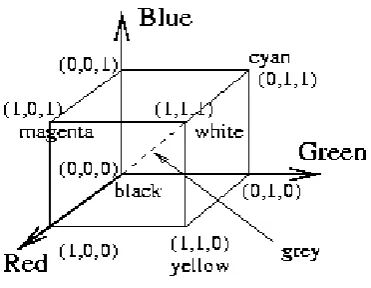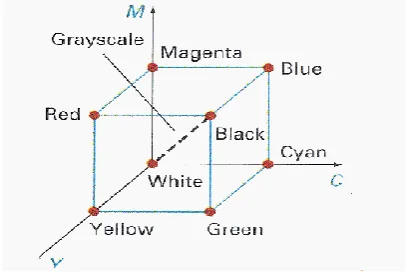Akshata A Kulkarni et al, International Journal of Computer Science and Mobile Applications,
Vol.3 Issue. 11, November- 2015, pg. 5-10
ISSN: 2321-8363
©2015, IJCSMA All Rights Reserved, www.ijcsma.com 5
A Review on Color Image Processing
Akshata A Kulkarni
1, Rutuja D Kurundkar
2, Sneha V Khare
3,
Shubhashree Savant
4, Prashant Chintal
51, 2, 3Student, TYMCA (A), MIT (E) College, Aurangabad (M.S.). akshata.kulkarni50@gmail.com ,
kurundkarrutuja96@gmail.com , sneha.khare047@gmail.com
4, 5
Asst. Prof.MCA Dept. MIT (E) College, Aurangabad (M.S.). shubhashree.savant@mit.asia,
prashant.chintal@gmail.com
Abstract:
The aim of Color Image Processing is to display image information for human perception. It is also fundamental step of digital image processing. It gives the applications of image processing which extract the features from image data, from which description, understanding and information can be obtained by machine. This system allows user to take hard copy of an image using printer and other output devices such as scanner etc; and also store the screen image into the disk file using file format (.jpg, .gif, .png etc.). It relates the image properties such as alteration and analysis of pictorial information. Nowadays image processing is used in our daily life. The most powerful image processing system is the one that interact with human brain together with the human eye. The main objective of this paper is to review development and implementation of color image processing which is necessary to operate upon images and visually enhance the images.
Keywords: Color models, RGB, CMY, HSI, YIQ
1. Introduction:
The early trade of color image processing of digital images was in the newspaper industry and images were transmitted by submarine cables between London and New York. In early processing digital image produced a coded tape by a telegraph printer. In the mid trade of color image processing which improves to the Bartlane system resulted in higher quality images and photographic process. Digital image processing used in medical imaging, remote earth resources and astronomy. Today's trade of digital image processing has grow vigorously. Today it is used in geography, biology, nuclear machine, archeology, law enforcement, defence and industry.
Color Image processing is used to provide digital image processing and it is in 2-dimensional format. Digital image processing define the processing of images which are digital in nature by a digital computer. Color image provide a image information for each pixel. Pixel is small unit of programmable color on color image. Color images are stored in memory as a raster map or raster graphics images. In Computer graphics, raster graphics images are stored in image files with varying formats. A raster graphics images are viewable via monitor, paper or other display medium. It is a dot matrix data structure which represent a rectangular grid of pixels.
Akshata A Kulkarni et al, International Journal of Computer Science and Mobile Applications,
Vol.3 Issue. 11, November- 2015, pg. 5-10
ISSN: 2321-8363
©2015, IJCSMA All Rights Reserved, www.ijcsma.com 6
Image processing provides various features like image shrinking, image scaling, image compression, image rotation. Image compression is work with BMP format gray scale images. Image rotation is used to rotate the image by specified angle. Resembling is used to increase the size of each pixel by a certain factor. Image shrinking is used to shrink the image and it is useful for saving the disk space. Image scaling include the zooming and shrinking of an image.
The color model uses standard implementation that is HSI (Hue, Saturation, Intensity). The hue is determined by the dominant wavelength. Visible colors occur between about 400nm (violet) and 700nm (red) on the electromagnetic spectrum [1]
Figure 1: Spectrum
2. Color image models
To utilize color as a visual cue in multimedia, image processing, graphics and computer vision applications, an appropriate method for representing the color signal is needed. Color model literature can be found in the domain of modern sciences, such as physics, engineering, artificial intelligence, and computer science [6]. With the color format, a digital image can record and provide more information than the gray scale format image does.
Digital acquisition devices (such as scanners and digital cameras) can separate beams of light into three primary colors- red, blue, and green, through the assistance of spectroscopes and filters. In order to record the color information, we need at least three parameters (e.g. red, blue, and green) to represent a color. We use the color model to represent the color information of digital images. Since we need three parameters to represent a color, those color models must be with a three dimensional format. The models use some mathematical functions to represent a point position (in the three dimensional space) that is assigned to a color. Some color models (RGB, CMY, HSI , YIQ) are summarized as follows
2.1 RGB color model
The three primary colors (red, green, and blue) and their combination in visible light spectrum are shown in Fig.1. With different weights, (R, G, B), their combination can indicate different colors. After normalizing the values of R, G, B, we can get the color cube (Fig.2). The colors on the diagonal line, from the origin to the coordinate (1, 1, 1) of the cube, means the gray-level values [3].
When the RGB model is used, each colour could be presented in a coordinate system, where each of the “primary”
RGB colours varies from zero to maximum value (e.g. from 0 to 1, or from 0% to 100%, or from 0 to 255 brightness levels, etc) [7]. R color and normalized RG colors (r, g) are used to set up the adaptive skin color model because (r, g,
Akshata A Kulkarni et al, International Journal of Computer Science and Mobile Applications,
Vol.3 Issue. 11, November- 2015, pg. 5-10
ISSN: 2321-8363
©2015, IJCSMA All Rights Reserved, www.ijcsma.com 7
Figure 2: RGB graph of the primary colors
Figure 3: RGB graph of the color cube
2.2 CMY color model
The CMY color model is based on complementary colors- cyan, magenta, yellow. This color model can be expressed as
Akshata A Kulkarni et al, International Journal of Computer Science and Mobile Applications,
Vol.3 Issue. 11, November- 2015, pg. 5-10
ISSN: 2321-8363
©2015, IJCSMA All Rights Reserved, www.ijcsma.com 8
Figure 4: CMY color model
Figure 5: CMY graph of color
2.3 YIQ color model
The YIQ color model is designed to refer to the characteristics of the human's visual system. In the human's visual system, people are more sensitive to the lightness component than the hue component. So, the YIQ color model is set to separate colors into luminance (Y) and hue (I and Q). The relationship between YIQ and RGB is expressed as
where Y is the luminance, I and Q indicate the weights of hue.
The advantage of the YIQ color model is that we can deal with the luminance component independently. The YIQ color model is the standard model applied to the signal transmission of color TV sets [3].
2.4 HSI color model
HSI model is proposed to improve the RGB model. The Hue Saturation Intensity (HSI) color model closely resembles the color sensing properties of human vision. To formula that converts from RGB to HSI or back is more complicated than with other color models [2].
Akshata A Kulkarni et al, International Journal of Computer Science and Mobile Applications,
Vol.3 Issue. 11, November- 2015, pg. 5-10
ISSN: 2321-8363
©2015, IJCSMA All Rights Reserved, www.ijcsma.com 9
3. Literature Review
1. A review on various color models, their description, comparison and evaluation results is presented. These models are used various components of an image to display on specific hardware platform. The main purpose of a color model is to provide the specification of colors. The research work shows converting the various models to speed up the image processing with least time delays and it gives invariance in results of various models due to complex mathematical equations. The various image processing methods i.e. adaptive histogram equalization and contrast limited adaptive histogram equalization can be used to speed up the image processing by using these color models [2].
2. Edge detection techniques like gradient-based and laplacian-based techniques. Edge detection is a significant task for image segmentation used for object detection and many other applications. First-order derivatives in an image are computed using the gradient. Second-order derivatives are obtained using the Laplacian Result of edge detection techniques vary from set of images [5].
3. The use of gradient operators like Roberts, Prewitt and Sobel for color image edge detection. This objective is fulfill through the experiments perform on around 50 different color images. The weight values of mask are used to achieve some smoothing of edges of images by giving more stress on central point. The Prewitt and Sobel operators have given more prominent enhance edges. Among these two masks the Sobel mask has slightly superior noise suppression characteristics which are important with derivative features. Another fact found in result is that the Prewitt and Sobel mask gives isotropic results only for vertical and horizontal directional edges [4].
4. Conclusion
In this paper, we review on some color image models and explain how we apply image processing with the help of these color models. The colors are used in object identification and simplify extraction from a scene and it is powerful descriptor. The humans can used thousands of color shades and intensities. The color models are based on color recognition and color components. The research work shows the conversions of various models to speed up the image processing with least time delays. In future, we will try other color models and find their capability for aiding the processing of forensic sciences.
References
[1] Rafael C. Gonzales, Richard E. Woods. “Digital Image Processing”. second edition, Prentice Hall,2002.
[2] Harmeet Kaur Kelda,Prabhpreet Kaur “A Review: Color Models in Image Processing” .Harmeet Kaur kelda et al ,
Int.J.Computer Technology & Applications,Vol 5 (2),319-322 ISSN:2229-6093
[3] Che-Yen Wen,Chun-Ming Chou “Color Image Models and its Applications to Document Examination.Forensic
Science” Journal 2004;3:23-32
[4] Shubhashree S. Savant , Ramesh Manza “Color Image Edge Detection using Gradient Operator” International Journal of Emerging Trends & Technology in Computer Science (IJETTCS) ISSN 2278-6856
[5] Shubhashree Savant. “A Review on Edge Detection Techniques for Image Segmentation” (IJCSIT) International Journal of Computer Science and Information Technologies, Vol. 5 (4) , 2014, 5898-5900 ISSN :0975-9646
[6]Rupali Nayyer and Bhubneshwar Sharma “Use and analysis of Color Models in Image Processing” Rupali Nayyer
and Bhubneshwar Sharma /International Journal of Advances in Scientific Research 2015; 1(08): 329-330 Journal DOI: 10.7439/ijasr(Online) ISSN: 2395-3616
[7] Slavik D Tabakov “INTRODUCTION TO VISION, COLOUR MODELS AND IMAGE COMPRESSION”
Akshata A Kulkarni et al, International Journal of Computer Science and Mobile Applications,
Vol.3 Issue. 11, November- 2015, pg. 5-10
ISSN: 2321-8363
©2015, IJCSMA All Rights Reserved, www.ijcsma.com 10
[8] Nishad PM and Dr. R.Manicka Chezian “VARIOUS COLOUR SPACES AND COLOUR SPACE CONVERSION
ALGORITHMS” Volume 4, No. 1, January 2013 ISSN-2229-371X
[9] Chen-Chiung Hsieh, Dung-Hua Liou and Wei-Ru Lai “Enhanced Face-Based Adaptive Skin Color Model” Journal
of Applied Science and Engineering, Vol. 15, No. 2, pp. 167-176 (2012)
A Brief Author Biography
Akshata Abhaya Kulkarni – Student of Third year of Master of Computer Application (Under Engineering and Technology) of Marathwada Institute of Technology(E), Aurangabad(M.S.). Completed B. Sc. (C.S.), Research interests are Image Processing, Cryptography and Mobile Computing.
Rutuja Diwakar Kurundkar – Student of Third year of Master of Computer Application (Under Engineering and Technology) of Marathwada Institute of Technology(E), Aurangabad(M.S.). Completed B. Sc. (C.S.), Research interest is Image Processing.
Sneha Vitthal Khare – Student of Third year of Master of Computer Application (Under Engineering and Technology) of Marathwada Institute of Technology(E), Aurangabad(M.S.). Completed B. Sc. (C.S.), Research interest is Image Processing.
Shubhashree Savant –Asst. Prof., MCA Dept. of Marathwada Institute of Technology (E), Aurangabad(M.S.). Completed M.Sc. (Computer Science), MCA and M.Phil. (ComputerScience), Research interests are Image Processing, Network security, Cryptography and Steganography, Hadoop and Big Data Analysis.
Prashant Chintal – Asst. Prof., MCA Dept. of Marathwada Institute of Technology(E), Aurangabad(M.S.). Completed MCA


